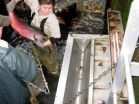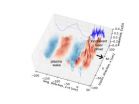(Press-News.org) CORVALLIS, Ore. – A new study by researchers at Oregon State University suggests that wild coho salmon that choose mates with disease-resistant genes different from their own are more likely to produce greater numbers of adult offspring returning to the river some three years later.
The researchers also found that hatchery-reared coho – for some unknown reason – do not appear to have the same ability to select mates that are genetically diverse, which may, in part, explain their comparative lower reproductive success.
Results of the study have been published in this month's Canadian Journal of Fisheries and Aquatic Sciences. Funding was provided by the Oregon Watershed Enhancement Board, The Coastal Oregon Marine Experiment Station, Oregon Sea Grant, and the Oregon legislature.
"This is the first study to examine mate choice among wild-spawning fish of both hatchery and wild origin, and the results suggest that greater diversity of immune genes between wild-born pairs of coho salmon may increase offspring survival," said Amelia Whitcomb, who did the research as a master's student at OSU and is lead author on the publication.
"These findings, along with future research, may have important implications for hatchery supplementation programs," added Whitcomb, who now works for the Washington Department of Fish &Wildlife.
The key appears to be a suite of genes that include the major histocompatibility complex (MHC), which initiates immune response and ultimately provides disease resistance. Other factors, including size and timing of return to fresh water, also determined mate pair reproductive success. MHC genes are well-studied in many organisms, including humans, and have been shown to play a role in how individuals choose mates.
The researchers used genetic parentage analysis to study mating events among adult coho salmon – both wild-born and hatchery-reared – that returned and spawned in a natural context in the Umpqua River in southern Oregon. Adult coho salmon were fin-clipped for genetic identification so they could be linked to their offspring, which returned as adults three years later.
The researchers then compared reproductive success, defined as the number of adult offspring returns, from three different categories of naturally spawning mate pairs: two wild parents, two hatchery-reared parents, and a hatchery-reared/wild parent pair.
The study found that wild fish that bred with other wild fish that had dissimilar MHC profiles had an increased success rate compared to wild fish pairings of similar MHC diversity. In addition, wild fish that mated with hatchery fish that had intermediate rates of dissimilarity also had greater reproductive success than wild fish mated with hatchery fish that had little MHC diversity, or the greatest MHC diversity.
However, the mate selection of hatchery-raised fish with other hatchery-raised fish appeared to be totally random, according to Michael Banks, director of the Cooperative Institute for Marine Resource Studies at OSU's Hatfield Marine Science Center, and co-author on the study. In other words, hatchery-raised fish didn't appear to select mates based on any kind of genetic profile, "an indiscretion that may ultimately be lowering their reproduction success."
"Evidence that the MHC is associated with mate choice is common in many species through chemical cues detected by olfaction," Banks said, "so it isn't necessarily surprising that selecting for MHC diversity would increase reproductive success in salmon as well. What is puzzling is why hatchery-raised fish appear to have lost that ability."
Kathleen O'Malley, an assistant professor of fisheries and wildlife at OSU and co-author on the study, cautioned that genetic diversity is just one factor in mate selection and reproductive success.
"The ocean is like a black box for salmon and many factors can play a role in their survival," said O'Malley, a geneticist with the Coastal Oregon Marine Experiment Station at OSU's Hatfield Center. "But the strength of this study is that it looks at the bottom line, which is what creates the best chance of success for salmon to produce offspring that survive to return as adults."
O'Malley said the next logical step in the research is to develop selective breeding strategies that better emulate mating strategies that occur in the wild and to learn whether new strategies can reduce the difference in reproductive success among hatchery-raised and wild fish.
INFORMATION: END
Wild coho may seek genetic diversity in mate choice
2014-05-28
ELSE PRESS RELEASES FROM THIS DATE:
Increased social network can have big payoff for nonprofits, study shows
2014-05-28
BUFFALO, N.Y. — Charitable fundraising once depended primarily upon a charity's size, efficiency and longstanding reputation. That was before Razoo, Chipin, Facebook and Twitter came to town.
In the first academic study to look at what determines charitable giving on social-media sites, researchers found that those media have created a more level playing field in the nonprofit world, one in which successful use of technology can make up for limited organizational size.
Technology and social media, it turns out, can not only raise the online profile of even small organizations, ...
How long should HCV treatment last? Study suggests answers are complex
2014-05-28
BUFFALO, N.Y. – As new treatments for hepatitis C virus (HCV) are approved, biomedical scientists are exploring their mechanisms and what they reveal about the virus. An online publication this month in Hepatology is the first to report real-time tracking of viral decay in the liver and blood in 15 patients with HCV.
Led by Andrew H. Talal, MD, University at Buffalo professor of medicine in the Division of Gastroenterology, Hepatology and Nutrition and corresponding author, the study is the first to trace in real-time how the drug telaprevir inhibits viral replication ...
Study affirms value of epigenetic test for markers of prostate cancer
2014-05-28
A multicenter team of researchers report that a commercial test designed to rule out the presence of genetic biomarkers of prostate cancer may be accurate enough to exclude the need for repeat prostate biopsies in many — if not most — men.
"Often, one biopsy is not enough to definitively rule out prostate cancer," says study researcher Jonathan Epstein, M.D., director of the Division of Surgical Pathology and a professor of pathology, urology and oncology at the Johns Hopkins University School of Medicine. "Our research finds that by looking for the presence or absence ...
Women's contraceptive use influenced by contraception education and moral attitudes
2014-05-28
COLUMBIA, Mo. – Nearly half of all pregnancies in the United States are unintended, and unplanned pregnancies are associated with poorer health and lower rates of educational and economic achievement for women and their children, according to the Centers for Disease Control and Prevention. However, research shows that the desire to avoid pregnancy does not necessarily increase women's use of contraceptives, although this discrepancy is not well understood. Now, MU researchers have found that levels of prior sex education and moral attitudes toward contraception influence ...
Toxins in the environment might make you older than your years
2014-05-28
Why are some 75-year-olds downright spry while others can barely get around? Part of the explanation, say researchers writing in the Cell Press journal Trends in Molecular Medicine on May 28, is differences from one person to the next in exposure to harmful substances in the environment, chemicals such as benzene, cigarette smoke, and even stress.
While the birth date on your driver's license can tell you your chronological age, that might mean little in terms of the biological age of your body and cells. The researchers say that what we need now is a better understanding ...
Cocktail party neuroscience: Making sense of voices in a crowd
2014-05-28
This news release is available in French. Listening to a conversation in the context of a cocktail party presents a great challenge for the auditory system. Without realizing it, one must extract, from a complex mixture of sound, the sound of a single voice to understand and track it. Researchers at Queen's University, lead by Dr. Ingrid Johnsrude, are studying how our brains meet that challenge, and allow us to distinguish specific voices in crowded, noisy and distracting environments. Her studies have revealed that the brain does not simply rely on the incoming ...
New research shows memory is a dynamic and interactive process
2014-05-28
This news release is available in French. Research presented by Morris Moscovitch, from the Rotman Research Institute at the University of Toronto, shows that memory is more dynamic and changeable than previously thought. Dr. Moscovich's results reveal that important interactions between the hippocampus and the neocortex, two regions of the brain, have different yet complementary roles in remembering places and events. These results highlight that different forms of memories exist in the brain, and that these are encoded in different, but interacting parts of the ...
Uncovering clues to the genetic cause of schizophrenia
2014-05-28
NEW YORK, NY (May 21, 2014) — The overall number and nature of mutations—rather than the presence of any single mutation—influences an individual's risk of developing schizophrenia, as well as its severity, according to a discovery by Columbia University Medical Center researchers published in the latest issue of Neuron. The findings could have important implications for the early detection and treatment of schizophrenia.
Maria Karayiorgou, MD, professor of psychiatry and Joseph Gogos, MD, PhD, professor of physiology and cellular biophysics and of neuroscience, and their ...
A path toward more powerful tabletop accelerators
2014-05-28
Making a tabletop particle accelerator just got easier. A new study shows that certain requirements for the lasers used in an emerging type of small-area particle accelerator can be significantly relaxed. Researchers hope the finding could bring about a new era of accelerators that would need just a few meters to bring particles to great speeds, rather than the many kilometers required of traditional accelerators. The research, from scientists at the U.S. Department of Energy's (DOE) Lawrence Berkeley National Laboratory (Berkeley Lab), is presented as the cover story in ...
PTSD treatment cost-effective when patients given choice
2014-05-28
A cost-analysis of post-traumatic stress disorder treatments shows that letting patients choose their course of treatment – either psychotherapy or medication – is less expensive than assigning a treatment and provides a higher quality of life for patients.
In a recent study, published in the Journal of Clinical Psychiatry, PTSD patients allowed to choose between therapies ended up costing about $1,622 less on average per patient per year compared with patients who were assigned treatment. Among patients not given a choice, treatment with prolonged exposure psychotherapy ...



